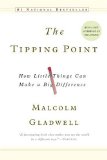“The Tipping Point” by Malcolm Gladwell is a book that expands upon an article by the author in the New Yorker published in 1996. It seeks to explore how ideas, products, messages and behaviours “tip over” and suddenly spread through or recede from society, just like pathological epidemics through a population. These are termed “social epidemics” by the author. Understanding such phenomena can help us effect a desired change in society (e.g. market a product or spread a message).
The book is full of several interesting anecdotes on a wide range of topics. These include the sudden rise in popularity of Hush Puppies shoes, the sudden fall in the crime-rate in New York in the 1990s, the spread of syphilis through Baltimore, the midnight ride of Paul Revere in 1775, the continued rise in smoking among teens despite several measures by the government and social workers, etc. All these anecdotes are presented to support various points of the author's thesis, though it is not evident how you can decisively conclude anything from these given the lack of hard data. Nevertheless the anecdotes do enliven the book preventing it from becoming a dry and dull read.
The author presents three “rules of social epidemics”:
- The Law of the Few - a few people with rare social gifts are key to spreading epidemics. “Connectors” are the bridges that link a lot of people from different groups, “Mavens” actively seek knowledge and spread it to others and “Salesmen” persuade people to adopt new things that they otherwise would be reluctant to try.
- The Stickiness Factor - an idea or a product should have an essence that makes it memorable for people and helps it stay on their mind beyond their initial exposure to it.
- The Power of Context - a social epidemic is sensitive to the time and place in which it occurs. Without the right context, it will fizzle out.
These are intriguing ideas to be sure, but there is no conclusive evidence in the book to support them or to indicate that they are the only ones that matter. There are also several leaps of logic in making deductions (“X happened and it was because of Y”) that are not at all clear to me. For example, the author ultimately attributes the fall in the crime-rate in New York in 1990s to “fixing broken windows”, while “Freakonomics” demonstrates otherwise (and attributes it to the freedom of abortion of unwanted pregnancies resulting in fewer unwanted babies).
The book thus appears flawed to me, though it is a must-read simply to make sense of what many people keep talking about. If you hear phrases like “tipping point”, “social epidemic”, “broken windows theory”, “bystander effect”, “smoking is not cool - smokers are”, etc. dropped into your conversations, this is the book that can give you the necessary background. It is light and quick reading and available at a cheap price.
